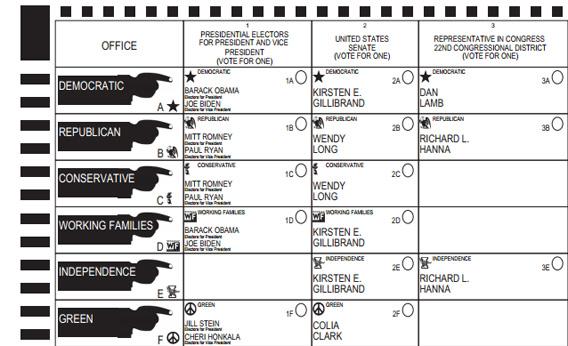Inauguration weekend is as good a moment as any for Americans to celebrate the political differences between say, Ohio and Syria. But let?s not forget how narrowly, back in November, we avoided another Florida 2000-style election debacle.
The shambolic state of ballot design in America remains a potent threat to our democracy. Richard L. Hasen, a leading election expert (and Slate contributor), says it best in his recent book: ?If you think that a dozen years later the country would have fixed its [election] problems ? you?d be dead wrong.? In the 2008 and 2010 elections, by one estimate [PDF], a combined total of more than half a million votes were not counted due to voter errors that imply poor ballot design. (For numerical context, Obama?s 2012 Ohio margin was around 166,000; had around 446,000 votes been different in 2008, President McCain would have won.) But 2012?s relative dearth of cliffhanger recounts, lawsuits, and Onion-caliber open warfare doesn?t mean we?ve fixed our ballots. We just got lucky.
I know it?s downright un-American to suggest we look abroad for guidance. Foreign countries generally feature only as counterexamples in our public discourse. Think Sweden (welfare snow-queens), Japan (economic stagnation), France (everything). But given the risks posed by our reckless lack of progress since Bush v. Gore, I figured it might be time?call me crazy?for America to phone a friend. What can we learn from ballot design in other countries?
The surprising answer: not much. Basically, it doesn?t matter how well other countries design their ballots, because such designs generally can?t be adapted to the unique characteristics of American democracy. Every expert I spoke to?after condemning the current state of American ballots?let out a long sigh and proceeded to explain why foreign examples aren?t much help. Here's why:
Local control. In most other countries, ballots are designed nationally, even for local elections. U.S. ballots are designed by a huge variety of local jurisdictions, often operating within some seriously nutty state mandates. In New York state, for example, ballots are for some reason required to have a fist and a finger ?at the head of the column or the beginning of the row containing the names of candidates.? New York City gives this requirement, well, the finger?the required symbol is that almost imperceptible dot in the corner of the boxes marked A, B, C, etc. in this image?while Whitestown, N.Y., takes this absurd requirement more seriously. To improve ballot design to a single national standard, someone?Washington, D.C.?would have to wrest control from every jurisdiction nationwide.
 Whitestown, NY., voting ballot.
Whitestown, NY., voting ballot. Courtesy Oneida County.
Election machinery. Another consequence of local control: U.S. jurisdictions have a huge variety of voting machines and protocols. Lawrence Norden, deputy director of the Brennan Center?s Democracy Program, told me ?a lot of equipment simply won?t handle best design practice.? These machines would need to be standardized before a nationally standardized ballot could be counted (or even displayed, for electronic ballots). Imagine the cost, and the inevitable fight over a national move to a single voting technology. Nor are electronic voting machines (which Norden says we?re moving away from anyway) much help. If anything, designing a clear electronic ballot may be more difficult than designing a clear paper one.
Referendums. As Whitney Quesenbery, a usability and ballot design expert, told me, Americans ?are fairly unique in what we put on our ballots.? In few other countries are ballots so packed with initiatives and referendums. The growing number of such ballot questions (more in 2012 than in any presidential election for the last 20 years), and their wordiness (in many jurisdictions the questions aren?t effectively summarized), present an enormous challenge for designers aiming to create an open, easy visual experience.
Electoral Complexity. Norden and Quesenbery both note that the United States, due to its federal structure and the number and variety of local jurisdictions, simply has more complex elections than nearly any other country. It?s not just the referendums. For example, we don't vote for president, we vote for electors for president. That distinction, spelled out on some ballots, creates visual clutter. We allow write-in candidates; many countries don't. Some U.S. jurisdictions permit straight ballot voting, where you check off a party that carries all your votes. Some allow straight ballots, but not for president.?Then there?s fusion voting, in which candidates can appear for the same contest under multiple parties. To fit all this onto a ballot, let alone to explain it visually, is a challenge only American ballot designers face. All this before you try standardizing ballot design across disparate U.S. jurisdictions.
Languages. Compared with many countries, jurisdictions in the multicultural U.S. tend to put multiple languages on ballots [PDF]. Design-wise, including information in even two languages is a huge visual complication, and some ballots feature more than two. Most other multilingual countries get around this by having separate ballots for different languages; by using symbols; by having only one or two official languages; or by having an official language for individual geographic regions. Or they ignore their linguistic minorities.
Irreconcilable differences. Finally, lots of countries don't vote the way we do. In some European countries, for example, you select a ballot that matches your choice from a magazine rack, and put that in the box as your vote. Straightforward and fairly immune to design failures, but not easily adaptable to American elections with many different contests and referendums.
Make no mistake?many countries have characteristics that complicate ballot design. But none have a cocktail quite as complex as America?s, let alone so much internal variation.
Source: http://feeds.slate.com/click.phdo?i=e63a46302b4692b0d391ff4c44d4531d
calvin johnson calvin johnson festivus festivus nfl playoff picture nfl playoff picture Peter Billingsley
No comments:
Post a Comment
Note: Only a member of this blog may post a comment.